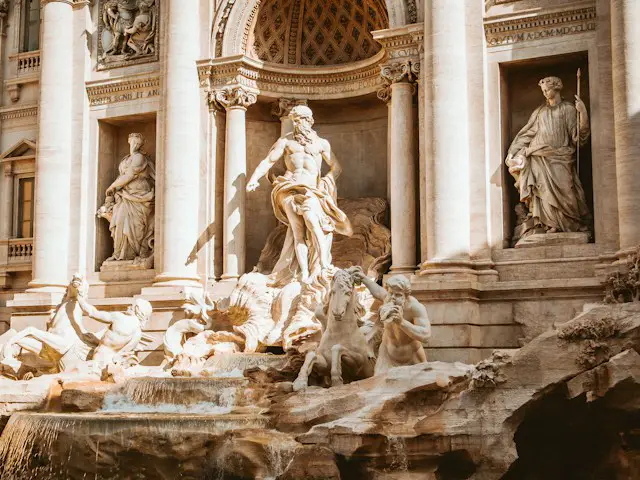
When it comes to architectural history, the Baroque and Renaissance periods stand out as two of the most influential and distinctive eras.
Both styles have left an indelible mark on the world of architecture, each with its own unique characteristics and aesthetic principles.
In this article, we will delve into the key characteristics of Baroque and Renaissance architecture, explore their differences, and examine their lasting impact on the built environment.
Key Characteristics of Baroque vs Renaissance Architecture
Renaissance

Renaissance architecture is a style of architecture that emerged in Italy during the 15th century and spread throughout Europe.
It is characterized by a revival of ancient Greek and Roman classical architectural forms and supplanted the prevailing Gothic medieval aesthetic.
Some key characteristics of Renaissance architecture include:
- Read also: Spanish Renaissance Architecture
- Read also: A Glimpse into Ancient Roman Artifacts
Symmetry and proportion
Renaissance architecture focused on the classical notions of beauty based on proportion and symmetry.
Many building plans were symmetrical squares, and columns, pediments, arches, and domes were imaginatively used in buildings of all types.
Ashlar masonry
The exteriors of Renaissance buildings typically featured ashlar masonry, a style of masonry in which stones are cut uniformly in a square or rectangle and then laid horizontally with minimal mortar.
Classical elements
Renaissance architecture used many classical elements, including domes, columns, pilasters (rectangular columns), lintels (a type of beam), arches, and pediments (triangular gables), among others.
Air and light
Early Renaissance buildings focused on bringing in air and light to the space, which was a nod to the dawning of Renaissance ideals and thought.
Innovation and mixing of styles
Renaissance architecture borrowed many elements from ancient Greek and Roman buildings but was not an exact replica.
Both architects and artists were deeply encouraged to create elements or motifs that would go well with ancient ones.
Even Michelangelo would often innovate ancient motifs and advised his colleagues to do the same.
Studying the past
Renaissance architects studied the mass of Greco-Roman ruins still seen in southern Europe, especially in Italy.
They also studied Byzantine buildings, features of Romanesque architecture, and medieval buildings.
For many Italian architects, the Gothic style was regarded as an invasive ‘northern’ invention that ‘corrupted’ Italian traditions.
In many ways, then, Renaissance architecture was a return to Italy’s roots, even if medieval architecture was never wholly abandoned.
Orderly arrangements
Renaissance style places emphasis on symmetry, proportion, geometry, and the regularity of parts, as demonstrated in the architecture of classical antiquity and in particular ancient Roman architecture, of which many examples remained.
Orderly arrangements of columns, pilasters, and lintels were used.
Classical detail and ornamentation
The study of classical antiquity led to the adoption of classical detail and ornamentation.
Space, as an element of architecture, was used differently than it was in the Middle Ages.
Space was organized by proportional logic, its form and rhythm subject to geometry, rather than being created by intuition as in Medieval buildings.
Rise of architectural theory
During the Renaissance, there was a rise of architectural theory.
Architects wrote books on their subject, and the most notable examples of Renaissance architecture in that city are the Cappella Caracciolo, attributed to Bramante, and the Palazzo Orsini di Gravina, built by Gabriele d’Angelo between 1513 and 1549.
Classical orders
The Classical orders were analyzed and reconstructed to serve new purposes.
While the obvious distinguishing features of Classical Roman architecture were adopted by Renaissance architects, the forms and purposes of buildings had changed over time, as had the structure of cities.
Baroque

Baroque architecture is a highly opulent and dramatic style that originated in Italy during the 17th century and spread to the rest of Europe.
Some key characteristics of Baroque architecture include:
Grandeur and drama
Baroque architecture is characterized by a sense of grandeur, drama, and contrast, especially in lighting.
It aimed to create visually impressive and emotionally evocative spaces.
Curvaceousness and organic lines
Baroque buildings often feature curvaceous and organic lines, with an emphasis on creating dynamic and theatrical forms through the manipulation of classical orders, curvature in walls and facades, and the dynamic sequencing of spaces.
Elaborate motifs and decorations
Baroque architects employed elaborate motifs and decorations, often with an emphasis on organic, curving lines and bright colors.
The style is marked by extremely detailed forms, marble, large-scale decoration, and bright colors.
Use of illusion
Baroque architecture often used illusion to create the impression of costly materials.
For example, architectural sculptures and vegetal and ornamental motifs became critical elements for helping the eye of the viewer flow.
Mastery of light
Baroque artists paid close attention to light. Finishes were chosen based on how the light would reflect, and areas of intense light and darkness were incorporated to show contrast and create drama.
Monumentality
Baroque buildings convey a sense of monumentality even when the space is actually small.
The style aimed to create embodied experiences of architectural space.
Gilded sculpture and interior design
Baroque architecture often featured gilded sculpture on the interior and exterior, with statues made from plaster or marble and included high contrasting colors and textures.
Attention-grabbing features
Baroque buildings often included attention-grabbing features such as curved walls, painted ceilings, vaulted ceilings, columns, sculptures, arches, niches, fountains, scrolling, broken pediments, etc., many of which give off a sense of motion known as dynamism.
Use of chiaroscuro
Baroque architecture made extensive use of Chiaroscuro, an artistic technique that uses strong contrasts between light and dark to create a sense of volume in modeling three-dimensional objects.
Key Differences Baroque vs Renaissance Architecture
To better understand the differences between Baroque and Renaissance architecture, let’s examine three key aspects: facade, interior spaces, and use of materials.
| Aspect | Renaissance Architecture |
Baroque Architecture
|
| Facade | Emphasized symmetry and proportion. Often featured classical elements such as columns and pilasters. |
Characterized by grandeur and dynamism. Elaborate ornamentation, dramatic forms, and undulating facades.
|
| Interior Spaces | Open and airy interiors with harmonious proportions. Use of domes and arches to create a sense of space. |
Dramatic and theatrical interiors. Use of light and shadow to create a sense of movement and emotional impact.
|
| Use of Materials | Preferred use of classical materials such as marble and stone. |
Utilized rich materials such as gold leaf, stucco, and colored marbles to create a sense of opulence.
|
Impact and Legacy
Renaissance architecture impact
The influence of Renaissance architecture reverberates through history, evident in landmarks like the Florence Cathedral and St. Peter’s Basilica in Rome.
The emphasis on classical forms and balanced proportions laid a strong foundation for subsequent architectural movements.
These iconic structures showcase the enduring impact of Renaissance ideals, shaping the evolution of architectural design.
Baroque architecture legacy
Baroque architecture, in contrast, has left an indelible mark through landmarks like the Palace of Versailles in France and St. Peter’s Square in Vatican City.
Characterized by its dramatic use of light, expansive spaces, and intricate ornamentation, Baroque architecture set the stage for exuberant styles that followed.
The legacy of Baroque design is evident in its ability to captivate and inspire, influencing the aesthetics of buildings across different periods.
- Read also: The Rise and Fall of the Roman Empire
- Read also: A Look at the 10 Best Roman Emperors
Conclusion
Baroque and Renaissance architecture signify two distinct epochs in architectural evolution, each embodying unique characteristics and aesthetic philosophies.
Renaissance architecture, characterized by its pursuit of harmony, balance, and adherence to classical forms, stands in contrast to the grandeur, opulence, and theatricality embraced by Baroque architecture.
Despite their differences, both styles have left a profound and enduring impact on the architectural landscape, serving as enduring sources of inspiration for architects and designers worldwide.
FAQs
Renaissance flourished in the 14th-16th centuries, followed by the Baroque era in the 17th-18th centuries.
Renaissance gems include the Sistine Chapel and Florence Cathedral. Baroque wonders include St. Peter’s Square and the Trevi Fountain.
They drew heavily from classical Roman and Greek architecture, seeking to revive its spirit.
Bold curves, dramatic contrasts, theatricality, illusionistic effects, intricate ornamentation, and use of light and shadow.
Both showcase grandeur, but Renaissance leans towards elegant restraint, while Baroque embraces flamboyant drama.


